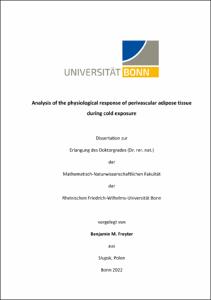Analysis of the physiological response of perivascular adipose tissue during cold exposure

Analysis of the physiological response of perivascular adipose tissue during cold exposure

| dc.contributor.advisor | Pfeifer, Alexander | |
| dc.contributor.author | Freyter, Benjamin M. | |
| dc.date.accessioned | 2023-02-22T12:52:21Z | |
| dc.date.available | 2024-03-01T23:00:23Z | |
| dc.date.issued | 22.02.2023 | |
| dc.identifier.uri | https://hdl.handle.net/20.500.11811/10654 | |
| dc.description.abstract | Aortic valve disease (AVD) is common for people over 65 and its severity increases with age. Aortic aneurysm (AA) is the tenth cause of death for men above 55. Its prevalence was estimated to be up to 8.9% for men and up to 2.2% for women. There is no pharmaceutical treatment for both diseases. The only treatment for the patients suffering from AVD or AA is surgery.
In the last two decades, adipose tissues gathered more attention due to discoveries that shows that adipose tissues serve as an energy storage and play important endocrine, paracrine and thermoregulatory roles. It has been found that adipose tissues secrete cytokines and miRNAs that influence other tissues and organs. Dysfunctional adipose tissue may be causing major diseases. Recently, perivascular adipose tissue gained more interest due to its location around blood vessels and new discoveries, which show that it regulates processes within vasculature and affects the development of atherosclerosis. To analyse secretory factors derived from adipocytes in PVAT, I have established a model of immortalized perivascular adipocytes (PVAi). Analysis of adipokines from PVAi and immortalized brown adipocytes (BAi) led to identification of substantially different secretory profile of those two cell types. Moreover, my work highlighted the additional vascular regulatory and regenerative function of PVAT. In addition, it provided high-throughput transcriptome analysis of cold-responsive, adipose tissue-derived cytokines and miRNAs and connected them with vast amount of data in DisGeNET database, emphasizing adipose-derived cytokines and miRNAs as prevention or treatment for AVD and AA. This work identified two most promising, cold-upregulated miRNAs in PVAT that together target 33% of RAGE, and 44% of MAPK pathways members. Up to my knowledge, my thesis describes for the first time cold-responsive, perivascular adipose tissue-derived miRNAs that inhibit RAGE and MAPK pathways and might be utilized to treat aortic valve disease and aortic aneurysm. | en |
| dc.language.iso | eng | |
| dc.rights | In Copyright | |
| dc.rights.uri | http://rightsstatements.org/vocab/InC/1.0/ | |
| dc.subject | RNA Sequencing | |
| dc.subject | Adipose Tissues | |
| dc.subject | Perivascular Adipocytes | |
| dc.subject | Perivascular Adipose Tissue | |
| dc.subject | Cold Exposure | |
| dc.subject | Aortic Valve Disease | |
| dc.subject | Aortic Aneurysm | |
| dc.subject.ddc | 500 Naturwissenschaften | |
| dc.subject.ddc | 570 Biowissenschaften, Biologie | |
| dc.subject.ddc | 610 Medizin, Gesundheit | |
| dc.subject.ddc | 615 Pharmakologie, Therapeutik | |
| dc.title | Analysis of the physiological response of perivascular adipose tissue during cold exposure | |
| dc.type | Dissertation oder Habilitation | |
| dc.publisher.name | Universitäts- und Landesbibliothek Bonn | |
| dc.publisher.location | Bonn | |
| dc.rights.accessRights | openAccess | |
| dc.identifier.urn | https://nbn-resolving.org/urn:nbn:de:hbz:5-69569 | |
| ulbbn.pubtype | Erstveröffentlichung | |
| ulbbnediss.affiliation.name | Rheinische Friedrich-Wilhelms-Universität Bonn | |
| ulbbnediss.affiliation.location | Bonn | |
| ulbbnediss.thesis.level | Dissertation | |
| ulbbnediss.dissID | 6956 | |
| ulbbnediss.date.accepted | 13.01.2023 | |
| ulbbnediss.institute | Medizinische Fakultät / Institute : Institut für Pharmakologie und Toxikologie | |
| ulbbnediss.fakultaet | Mathematisch-Naturwissenschaftliche Fakultät | |
| dc.contributor.coReferee | Bendas, Gerd | |
| ulbbnediss.date.embargoEndDate | 01.03.2024 | |
| ulbbnediss.contributor.gnd | 133336797X |
Files in this item
This item appears in the following Collection(s)
-
E-Dissertationen (4373)




